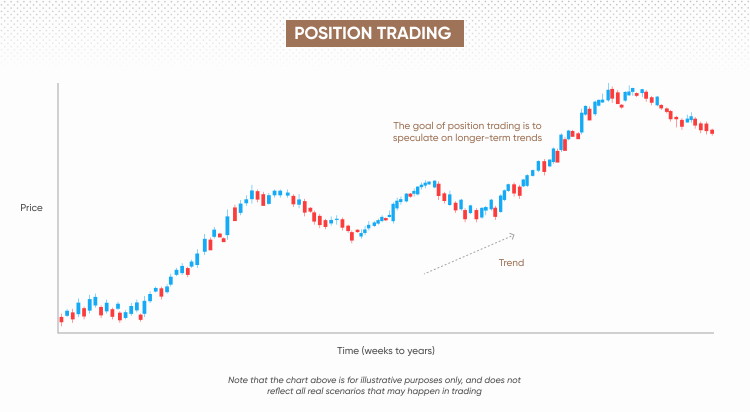Position trading strategy: an educational guide

Uncover the potential of position trading with our in-depth guide. Learn about position trading strategies, tools, and how it compares to other trading styles.
What is position trading?
Position trading is a common trading strategy where an individual holds a position in a security for a long period of time, typically over a number of months or years. Position traders ignore short-term price movements in favour of pinpointing and profiting from longer-term trends. It is this type of trading that most closely resembles investing, with the crucial difference being that buy-and-hold investors are limited to only going long.
Out of all the trading strategies, position trading encompasses the longest time-frame. Consequently, there is a greater potential for profit – as well as an increased inherent risk.
The advantages of position trading include limited maintenance of positions, capitalising on more substantial trends and dampening the ‘noise’ of the market.

Highlights
- Position trading involves holding a position open over a long period of time.
-
While it is similar to investing, position traders can speculate on market downturns by going short and do not own the underlying asset, unlike regular investors.
-
Position trading could apply to a range of markets, including stocks and shares, commodities, indices and derivatives.
Position trading vs other trading strategies
| Position trading | Day trading | Swing trading | |
| Time frame | Long-term | Short-term | Medium-term |
| Holding period | Months to years | Within a day | Days to weeks |
Position trading differs from day trading due to the length of time involved. While day traders attempt to open and close their trades within the course of a day, position traders take a longer approach. This could have other implications, such as the amount of money required to reach a profit target.
Likewise, swing trading differs from position trading as it involves holding positions for a few days to a few weeks, with the aim of capturing price movements in what could be described as a medium-term trading strategy. Position trading, meanwhile, largely picks up where swing trading leaves off. Again, swing traders and position traders could often have different goals and utilise different analytic techniques.
Why choose position trading?
Here are some potential benefits of position trading.
-
Reduced trading frequency: Position trading involves taking longer-term positions, which means traders don't have to monitor the market constantly. This could reduce stress and allow traders to focus on other activities or strategies.
-
Long-term profit potential: Position traders are aiming to capture larger moves in the market, and as such, they could potentially earn greater profits than shorter-term traders. However, there is also a possibility of bearing a loss.
-
Reduced transaction costs: Position traders enter and exit the market less frequently than day traders, which could result in lower transaction costs.
Risks of position trading
-
Market risk: Position traders are exposed to market risk, which means that their positions can experience significant losses if the market moves against them. This risk is higher for longer-term positions as market conditions can change over time.
-
Opportunity cost: Position traders are committing their capital to longer-term positions, which means they may miss out on other trading scenarios that arise in the short term.
-
Margin requirements: Position trading may require larger margin requirements, as traders are holding positions for longer periods. This can tie up more of a trader's capital, potentially limiting their ability to trade in other markets or take advantage of other opportunities.
Tools and techniques for position trading
There are a range of tools that position traders may consider.
Technical analysis
Technical analysis utilises tools that potentially identify patterns and trends that could help traders make informed trading decisions. Traders could use a variety of technical indicators, such as moving averages, relative strength index (RSI), and stochastics, to analyse the market and identify potential entry and exit points.
Fundamental analysis
Another important tool position traders may use is fundamental analysis. This involves analysing macroeconomic data, such as gross domestic product (GDP) growth rates, interest rates, and inflation, as well as company-specific information, such as earnings reports and financial statements. Using fundamental analysis could help traders identify undervalued or overvalued assets.
Risk management
Risk management may also be a key aspect of formulating a position trading strategy. Traders may consider a variety of tools to manage risk, such as stop-loss orders, which automatically close a losing trade if the price falls below a certain level. Note, however, that an ordinary stop-loss does not protect from slippage. For a fee, a trader may consider a guaranteed stop-loss order, which will close the position regardless of how volatile the market is.
Traders could also consider take-profit orders, which close a profitable position when it hits a particular level of profit a trader is willing to take, and a careful measuring of the risk vs reward ratio.
Developing a position trading plan
Position traders may consider taking these steps to design their trading strategy:
-
Choose their trading instrument: Position traders will need to decide whether they want to work with underlying assets, or derivatives.
-
Learn about technical and fundamental analysis: Doing so could prove useful, as it offers a wider range of tools that have the potential to help a trader understand the dynamics of the market trends.
-
Choose entry and exit points: A trader will need to decide where they want to get into the market and where they want to leave it.
-
Be aware of reversals: As position traders hold positions open over a long period of time, they may choose to ignore minor market fluctuations. However, that means they may fall victim to a trend reversal.
Key factors for position trading
Some of the key factors for position traders to consider include:
Long-term outlook: Since position trading involves taking a long-term view, having a strong understanding of market fundamentals, macroeconomic trends, and long-term trends may be important.
Patience: Position trading requires patience, as it could take time for a trade to develop and reach its profit target. Traders should be willing to hold onto their positions even during periods of market volatility.
Position sizing: Determining the appropriate position size may be important for position trading. Traders should ensure they have enough capital to withstand market fluctuations while still having enough buying power to take advantage of market opportunities. Position sizing could also impact risk management, as larger positions may require tighter stop-loss orders.
Conclusion
In conclusion, position trading is a form of trading which involves holding a position open for an extended period of time, making it somewhat different from shorter-term strategies such as day trading and swing trading. Position traders may choose to utilise a variety of instruments to trade in, from conventional stocks and shares to derivatives such as CFDs.
A position trader could use a variety of technical and fundamental analysis tools, coupled with research, to form a position trading plan.
However, position trading carries a lot of risk with it. With the extended time period involved, the possibility of the market moving against the trader increases, as does the potential for losses. Therefore, position traders need to make sure that they conduct their own due diligence, remembering that the market can move against them, and never trade with more money than they could afford to lose.
FAQs
Is position trading profitable?
Position trading could be equally profitable and loss-making. Markets are very often unpredictable, with a variety of factors having an impact on whether a trade is profitable or loss-making at any one time. Circumstances such as supply and demand dynamics, geopolitical events and market sentiment could all affect a trade.
Position trading vs day trading: What’s the difference?
Day trading is a short-term strategy with positions open and closed within the same day. Position trading, on the other hand, is a longer-term strategy, with positions held open for weeks, months and even years.
Position trading vs swing trading: What’s the difference?
Swing trading is a medium-term strategy, with positions open and closed over the course of a few days. Position trading, on the other hand, is a longer-term strategy, with positions held open for weeks, months and even years.